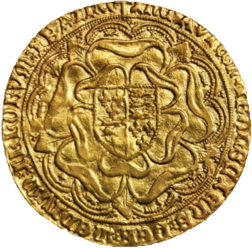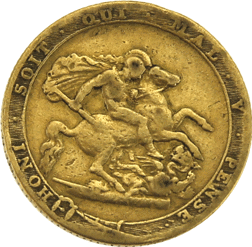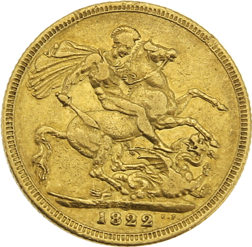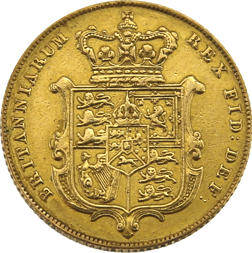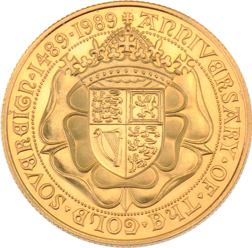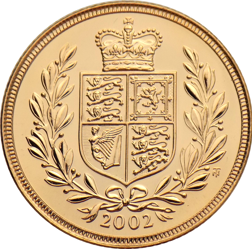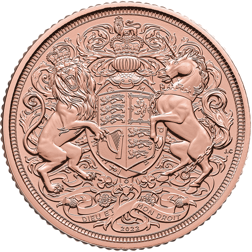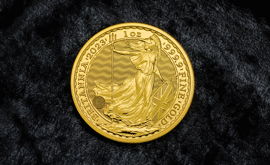The History of Gold Sovereign Designs
With its origins tracing back to over five hundred years ago, the gold sovereign coin is steeped in British history, regarded as a symbol of quality and reliability, and respected by collectors of precious metals across the world.
The flagship coin of The Royal Mint, the sovereign coin traditionally features the current reigning monarch on the obverse, and St George and the dragon on the reverse. However, throughout the years there have also been some commemorative designs honouring historic events. In this guide we will take a detailed look at the design of the sovereign coin throughout its history.
1489 - The first gold sovereign design
The very first gold sovereign coin was struck at the Tower of London on the 28th of October 1489. This coin was requested by King Henry VII and featured an obverse design showing the King himself, enthroned and dressed in full coronation regalia, and a reverse design showing the royal arms, with a double rose symbolising the union of York and Lancaster after the Wars of the Roses. This new coin was to be the largest in value and size ever seen in England at the time and was used as a statement for England’s stability and the Monarch’s greatness after the turmoil of the Wars of the Roses.
This first sovereign coin’s issue did not last long as it came to an end in 1604, and a sovereign was not struck again until 1817.
1817 – The first modern sovereign design
The 1817 sovereign was introduced during the reign of King George III, and marked a significant moment as it was the first modern sovereign issued following the Great Recoinage of 1816.
The obverse of the 1817 sovereign coin featured a distinctive design showing a right-facing portrait of King George III. The reverse of the coin was designed by Benedetto Pistrucci, one of the most celebrated engravers in the world, and was commissioned to show a scene of St George fighting the dragon, representing England’s strength and conquest after Napoleon was defeated at the Battle of Waterloo. With this design, Pistrucci created a masterpiece of design which owed much to the art style of Ancient Greece. Featuring a muscular St George on horseback with a flowing cape, wielding a spear and trampling a dragon, the design was met with instant acclaim and is beloved to this day.
Benedetto Pistrucci’s original design featured a border bearing the words ’HONI SOIT QUI MAL Y PENSE’, which translates to ‘Evil unto him who thinks evil of it’.
1821 – Remodelled St George and the dragon
Four years after his original design was featured on the first modern Sovereign coin, Pistrucci’s St George and the dragon design was slightly changed. The border and wording which surrounded the scene was removed, leaving room for a larger and more detailed image, and St George’s broken spear was changed to a sword. The obverse of the coin featured the left-facing portrait of King George IV and was the first sovereign issued during his reign following his ascension to the throne in 1820.
1825 - George IV Shield of Arms Sovereigns
King George IV came to the throne in 1820, following the death of his father, George III, and the gold sovereigns minted in the early 1820s continued with Pistrucci’s iconic St George and the dragon reverse design. However, in 1825, this was replaced by an intricate design showing the crowned shield of the royal coat of arms, marking a significant change in the aesthetic of the gold sovereign coin. Designed by French engraver Jean Baptiste Merlen, the shield was surrounded by a mantle and featured the legend ‘BRITANNIARUM REX FID DEF’ which translates to ‘King of the Britains, Defender of the Faith.’
The first George IV sovereigns produced from 1821 featured a laureate head portrait of the King by Benedetto Pistrucci on the obverse of the coins. However, the King disliked how the artist had portrayed him and insisted that a new portrait was created. Pistrucci refused, leading to the task being handed to English engraver William Wyon. Wyon’s interpretation of King George IV (named the ‘bare head’ portrait as it omits the laurel wreath) was a kinder, more flattering portrait and appeared on the obverse of the sovereign together with the new shield of arms reverse design from 1825.
1830 - William IV Shield of Arms Sovereigns
The 1830 sovereign, issued during the reign of King William IV, featured a right-facing portrait of the king on its obverse, designed by William Wyon. These coins came in two slightly different designs, known as the first and second bust type, with each type varying slightly. Type one was only minted in 1831-1832 and features more prevalent curls in the King’s hair as well as a rounder ear. The second bust type was struck in 1831-1837 and features less curls in the hair, a more elongated ear with a flatter top, and a slightly different portrait alignment.
The reverse of the coin displayed an updated version of the previous crowned shield of arms surrounded by a mantle, making it more detailed. This design was engraved by Jean Baptiste Merlen and included the legend "BRITANNIARUM REX FID DEF," meaning "King of the Britains, Defender of the Faith." This sovereign design was used throughout the reign of William IV from 1830 until his death in 1837 and displayed the detailed and realistic engraving style of the period.
1838 – Victorian Shield Sovereigns
Upon Queen Victoria’s coronation, Jean Baptiste Merlen was commissioned to update the crowned shield design for the sovereign coin’s reverse once again. The Victorian shield sovereigns were minted between 1838 and 1887 and departed from the original St George and the dragon design, instead featuring a crowned shield of arms within a mantle, tied with a ribbon below. The legend ‘BRITANNIARUM REGINA FID DEF’ also features, signifying Victoria's status as Queen of the Britains and Defender of the Faith.
The obverse of the coins featured the left-facing ‘young head’ portrait of Queen Victoria, designed by engraver William Wyon who was personally chosen by Victoria as she thought he always portrayed her favourably.
Today, the Victorian shield reverse designs are sought after by collectors, often making them a little more valuable.
1871 – The return of St George and the dragon
After many years of the design being replaced by the shield, Benedetto Pistrucci’s beloved St George and the dragon reverse design made a comeback and was paired with the Queen Victoria portrait obverse for the first time in 1871. Both shield and dragon reverse designs ran concurrently until 1887, after which the St George and the dragon became the sole reverse design choice for the sovereign for over one hundred years.
From 1871 onwards, the obverse designs changed with each monarch, while the St George reverse design remained consistent. During Queen Victoria’s reign until her death in 1901, the obverse side of the sovereign featured her left-facing portrait, including the ‘young head’ portrait (1838-1887), the ‘jubilee head’ portrait (1887-1893), and the ‘old head’ (veiled head) portrait (1893-1901). Following Victoria, King Edward VII’s reign from 1902 to 1910 featured his right-facing portrait, engraved by Birmingham-born artist George William de Saulles.
When King George V ascended to the throne in 1910, The Royal Mint held a competition to design his coin portrait. This was won by sculptor Edgar Bertram Mackennal, whose 1911 depiction of the left-facing bearded King George V was the last to appear on gold sovereigns struck for circulation.
The only sovereigns issued between 1932 and 1957 were proof or specimen sets issued for King George VI’s coronation year of 1937, and featured the king facing to the left. Typically, each monarch’s portrait switches perspective from their predecessor. However, this portrait broke centuries of tradition in coin portraits of the monarchy as both George V and George VI face to the left. This is due to George VI personally preferring his left profile for his portrait.
Sovereigns were reintroduced in 1957, with the first portrait designed by Mary Gillick and portrayed a right-facing Queen Elizabeth II in her youth featuring ribbons in her hair. Queen Elizabeth II’s second (decimal) portrait was introduced onto gold sovereign coins in 1974. Designed by Arnold Machin, the portrait showed the queen wearing a tiara given to her by her grandmother, Queen Mary. In 1985 a third portrait was designed by Raphael Maklouf and was produced until 1997 (except in 1989) on sovereign coins with a proof finish only.
1989 – The 500th Anniversary Sovereign
1989 saw The Royal Mint commission Bernard Sindall to create a special design for the 500th anniversary of the original gold sovereign coin, with both the reverse and obverse of the coin mimicking the original sovereign from 1489. The obverse of the coin features Queen Elizabeth II seated at her coronation and is the first time the Queen was depicted seated on the throne.
The reverse of the coin depicts the crowned shield of the royal arms upon a double Tudor rose. This was the first change in the reverse side of the sovereign during the reign of Queen Elizabeth II, and the first time in over one hundred years that a design other than the St George and the dragon had appeared on the reverse.
These special coins are available as proof coins only and are highly collectable and sought after by collectors, often making them significantly more valuable.
2002 – The Golden Jubilee Sovereign
Produced to celebrate Queen Elizabeth’s Golden Jubilee, 2002’s sovereign saw another rare departure from the traditional St George and the dragon design and a return to a shield reverse. The coin was designed by Timothy Noad and features a similar crowned shield design to the one used by Queen Victoria, surrounded by a wreath.
The obverse of the coin bore the portrait of Queen Elizabeth designed by Ian Rank-Broadley which featured on sovereign coins from 1998. A more strongly realistic likeness of the Queen in her older years, the portrait appeared large within the centre of the coin, maximising its impact on the coins.
2005 – A modern St George
In 2005, The Royal Mint replaced Benedetto Pistrucci’s iconic design with a more modern interpretation of St George and the dragon on the reverse of the sovereign, for one year only. Unlike the special reverse designs for 1989 and 2002, this 2005 design was not issued to commemorate a special event or anniversary.
Designed by heraldic artist Timothy Noad, the bold new art-deco style design for 2005’s sovereign featured St George as a knight, holding a shield bearing the St George’s cross, and brandishing a broad sword mid-swing against the attacking dragon.
The obverse side of the coin featured Ian Rank-Broadley’s portrait of Queen Elizabeth II.
2012 – The Diamond Jubilee Sovereign
Produced to celebrate Queen Elizabeth II’s Diamond Jubilee, 2012’s sovereign featured another departure from the traditional Pistrucci version of St George, for a special one-off design. Decided by a competition held by The Royal Mint, sculptor Paul Day’s new design was chosen to appear on the reverse of the sovereign for this year only.
The coin featured a dramatic, more fearsome design which fills the full field of the coin, featuring St George in full armour on horseback as he slays the dragon by plunging his lance through the creature’s open mouth.
The obverse side of the coin bears the Ian Rank-Broadley portrait of Queen Elizabeth II.
2017 – The 200th Anniversary Sovereign
In 2017, the modern sovereign celebrated its 200th anniversary. The reverse of the anniversary coin featured the traditional St George and the dragon design by Benedetto Pistrucci, with the addition of a small shield mint mark with the number 200 placed below the defeated dragon to acknowledge the 200th anniversary.
The obverse of the coin featured the fifth and final coinage portrait of Queen Elizabeth II, first introduced in 2015. The portrait was designed by engraver Jody Clark, who had only worked as an engraver at The Royal Mint for two years before he entered and won the competition to design the new definitive coinage portrait of the Queen in homage to her milestone of becoming the longest reigning monarch in the history of Britain. Clark’s portrait showed a mature yet positive likeness of Queen Elizabeth II as she wears her coronation crown.
2022 – The Platinum Jubilee Sovereign
To commemorate Queen Elizabeth II's Platinum Jubilee, the 2022 sovereign featured another rare design change to the reverse side of the coin. The coin displays an interpretation of the crowned royal coat of arms designed by Timothy Noad (making this his third sovereign reverse design), flanked by the lion of England and the unicorn of Scotland.
The coin’s one-off design honoured the achievement of Queen Elizabeth II’s historic 70-year reign with this special commemorative design of The Royal Mint’s flagship coin.
The obverse of the coin featured Jody Clark’s portrait of Queen Elizabeth II wearing her coronation crown.
2022 – The Queen Elizabeth II Memorial Sovereign
Early 2023 saw the release of a new sovereign to honour the life and legacy of Britain’s longest-reigning monarch, Her Late Majesty Queen Elizabeth II who passed away in September 2022. The coin’s reverse design bore Jody Clark’s new intricate depiction of the crowned royal coat of arms and was dated 2022.
These special sovereign coins also featured a change of obverse design featuring King Charles III, marking the first time in over 65 years that a monarch other than Queen Elizabeth II had appeared. The portrait of King Charles III was designed by renowned sculptor Martin Jennings, and shows the King uncrowned and facing to the left.
Due to these memorial sovereigns featuring a change of design for both the reverse and obverse of the coin, they are often a popular choice for collectors.
2023 – The Coronation Sovereign
In July 2023, The Royal Mint released the Coronation sovereign which saw the return of the iconic St George and the dragon reverse, designed by Benedetto Pistrucci; the same design that featured on the first modern sovereign in 1817.
These coins were a little more special as they marked the special occasion of the historic coronation of His Majesty King Charles III. Only the second occasion a sovereign has featured a portrait of King Charles III, the 2023 coronation sovereign included the first ever official crowned coinage portrait of His Majesty. Designed by Martin Jennings, the same artist behind the first official coinage portrait of the King, the coronation portrait shows King Charles III facing left and wearing a crown.
Why are the newer sovereigns so pink in colour?
The unique physical characteristics and hues of gold are determined by the type and amount of metal that is alloyed with it. In the past, gold sovereign coins were crafted with a greater proportion of silver, giving them a more golden appearance compared to the more recent sovereigns. Sovereigns minted from the year 2000 onwards, incorporate a larger portion of copper, resulting in more of a pinkish or copper-toned appearance.
The sovereign in 2024 and onwards
Since that very first coin was struck in 1489, the sovereign has been a constant of British coinage, one that is admired and trusted throughout the world and through times of change.
First appearing on the sovereign in 1817, Benedetto Pistrucci’s design depicting St George and the Dragon has been a recurring tradition on sovereign coinage, enduring through various monarchs and their portraits as they have come and gone, changing only for a number of years during the reign of Queen Victoria and to commemorate significant events. Pistrucci’s beloved design is steeped in history and tradition, making the gold sovereign instantly recognisable across the world.
The sovereign itself has long been regarded as the ‘chief coin of the world’, valued not only for its gold content, but also for its enduring historical significance. Popular with investors due to its status as a VAT-free and Capital Gains Tax-exempt asset, highly prized and instantly recognisable, the sovereign’s legacy endures, making it an eagerly awaited release each year. Only time will tell whether Benedetto Pistrucci’s design depicting St George and the Dragon will remain the design of choice for future sovereign coinage, or whether new designs may emerge.
Why Join Our Mailing List?
By signing up, you'll gain access to exclusive updates, early announcements, and tailored insights into the world of bullion and precious metals.

Latest Updates On Bullion

New Releases

Special Offers

Market Analysis
This blog represents one person’s opinion only. Please note, gold and silver prices may go down as well as up. Atkinsons Bullion & Coins accepts no responsibility for any losses based on information we have provided. We do not offer investment advice. Please carry out your own research before making an investment decision.
